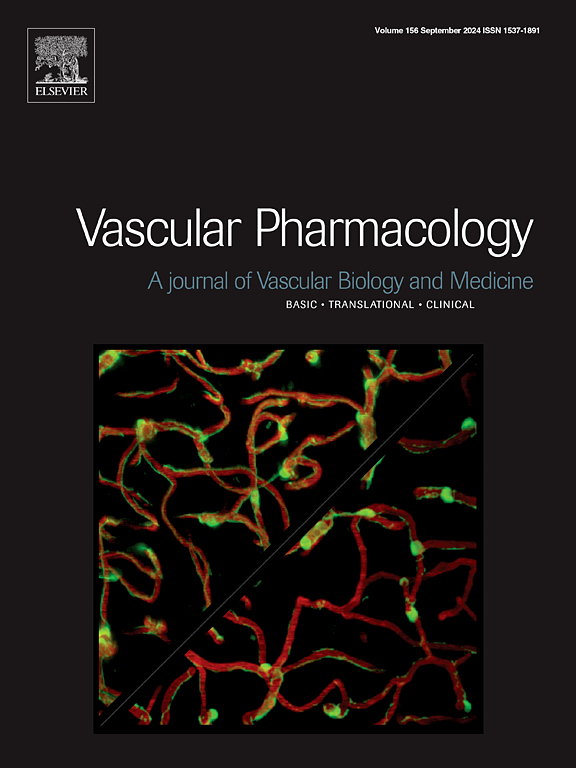Effects of simvastatin treatment on leptomeningeal collateral vessels: resistance, number and diameter
IF 3.5
3区 医学
Q2 PHARMACOLOGY & PHARMACY
引用次数: 0
Abstract
Good leptomeningeal collateral vessels (LMC) are associated with smaller lesion volume and better patient outcomes from ischaemic stroke, but their architecture varies greatly between individuals. Statins can stimulate angiogenesis and show promise for stimulating cerebral collaterogenesis. Statins could thus improve LMC grade and ensure all patients receive positive outcomes from treatment. This potentially explains why statin treatment is effective given prior to stroke in pre-clinical models, but not prescribed afterwards in clinical trials.
LMC-rich C57Bl/6 and LMC-poor BALB/c 12-week-old male mice were randomised to receive daily oral simvastatin (10 mg/kg) or vehicle for 4 weeks. The cerebrovasculature was silicone-perfused, allowing LMC numbers and dimensions to be analysed. Values for tortuosity, vascularity and LMC resistance were calculated.
In BALB/c, estimated resistance was lower with simvastatin treatment (vehicle: 0.104 ± 0.09, simvastatin: 0.023 ± 0.02; p = 0.04) and LMC numbers were greater (vehicle: 1.6 ± 1.6, simvastatin: 4.0 ± 3.2; p = 0.04). In C57Bl/6, there was no difference to resistance, but LMCs were smaller in diameter (vehicle: 16.3 ± 1.8 μm, simvastatin: 14.0 ± 1.4 μm, p = 0.008). Statin-treated C57Bl/6 also had more arterial branchpoints (left hemisphere, vehicle: 363.8 ± 55 per cm2, simvastatin: 417.3 ± 58 per cm2, p = 0.007; right, vehicle: 315.1 ± 40 per cm2, simvastatin: 397.5 ± 43 per cm2, p < 0.0001).
We have observed signs of collaterogenesis and angiogenesis, providing evidence that statins stimulate growth of LMCs. Greatest benefit was seen in LMC-poor BALB/c, suggesting that patients with poor LMC circulation stand to gain most from LMC-enhancing therapies. Patients receiving statins prior to stroke have likely developed better LMCs, leading to better stroke outcomes. These findings should stimulate investigation of further safe, widely-available LMC-enhancing therapies.

辛伐他汀治疗对小脑膜侧支血管的影响:阻力、数量和直径。
良好的小脑膜侧支血管(LMC)与缺血性脑卒中中较小的病变体积和更好的患者预后相关,但其结构在个体之间差异很大。他汀类药物可以刺激血管生成,并有望刺激大脑血管生成。因此,他汀类药物可以改善LMC分级,并确保所有患者从治疗中获得积极的结果。这可能解释了为什么他汀类药物治疗在临床前模型中风之前有效,但在临床试验之后却没有处方。富含lmc的C57Bl/6和缺乏lmc的BALB/c 12周龄雄性小鼠随机接受每日口服辛伐他汀(10 mg/kg)或对照药,持续4 周。经硅胶灌注的脑血管,可以分析LMC的数量和尺寸。计算弯曲度、血管性和LMC阻力值。在BALB/c中,辛伐他汀治疗的估计耐药性较低(对照:0.104 ± 0.09,辛伐他汀:0.023 ± 0.02;p = 0.04)且LMC数较大(对照药:1.6 ± 1.6,辛伐他汀:4.0 ± 3.2; = 0.04页)。C57Bl/6的耐药差异无统计学意义,但lmc直径较小(载体:16.3 ± 1.8 μm,辛伐他汀:14.0 ± 1.4 μm, p = 0.008)。他汀治疗的C57Bl/6也有更多的动脉分支点(左半球,载体:363.8 ± 55 / cm2,辛伐他汀:417.3 ± 58 / cm2, p = 0.007;右,载具:315.1 ± 40 / cm2,辛伐他汀:397.5 ± 43 / cm2, p
本文章由计算机程序翻译,如有差异,请以英文原文为准。
求助全文
约1分钟内获得全文
求助全文
来源期刊

Vascular pharmacology
医学-药学
CiteScore
6.60
自引率
2.50%
发文量
153
审稿时长
31 days
期刊介绍:
Vascular Pharmacology publishes papers, which contains results of all aspects of biology and pharmacology of the vascular system.
Papers are encouraged in basic, translational and clinical aspects of Vascular Biology and Pharmacology, utilizing approaches ranging from molecular biology to integrative physiology. All papers are in English.
The Journal publishes review articles which include vascular aspects of thrombosis, inflammation, cell signalling, atherosclerosis, and lipid metabolism.
 求助内容:
求助内容: 应助结果提醒方式:
应助结果提醒方式:


